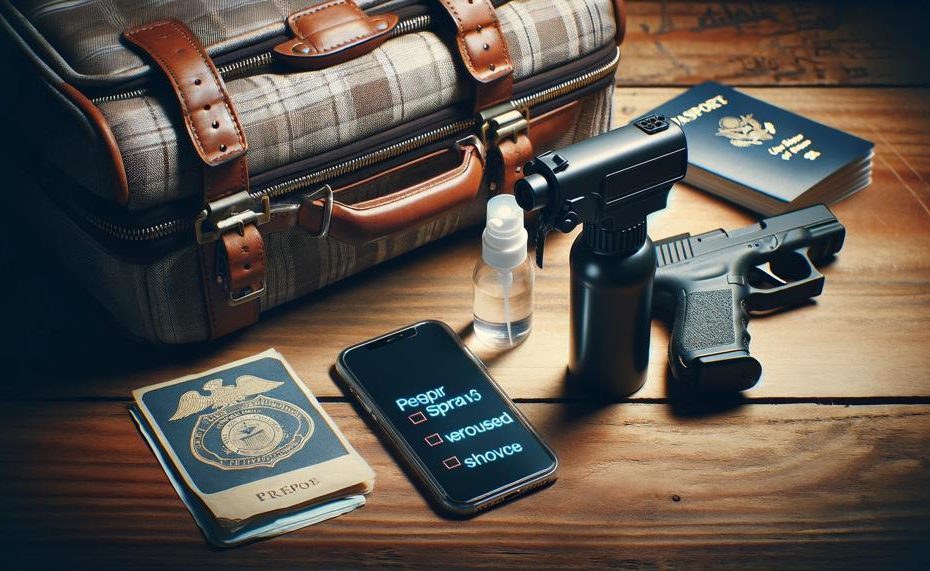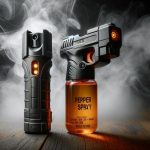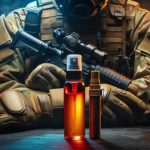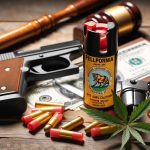Traveling can be an adventure, but ensuring your safety in unfamiliar places is a priority that’s as important as your passport.
Now, if you’re pondering whether your trusty pepper spray can tag along for the ride in your checked luggage, you’re not alone.
Navigating airport security rules can feel more complicated than trying to fold a fitted sheet, but don’t worry—we’re here to clear the air and offer you peace of mind alongside your packing cubes and travel-sized toiletries.
Before you zip up your suitcase and head for the airport, let’s dive into the nitty-gritty of flying with pepper spray:
- Airport Security 101: Understand the TSA’s stance on self-defense sprays.
- Pack Smart: Learn the proper way to pack pepper spray to avoid a luggage lockdown.
- Destination Matters: Why the rules might change based on where you’re heading.
So, fasten your seatbelt, because we’re about to take off into the world of travel regulations, ensuring you’re as prepared as a seasoned globetrotter with a penchant for safety.
Contents
Can you bring pepper spray on a plane?
Yes, pepper spray is permitted in checked baggage on a plane, subject to specific conditions. It must be contained in a single 4 fl. oz. (118 ml) container that incorporates a safety mechanism to prevent accidental discharge.
The content of the spray must not exceed 2% of tear gas (CS or CN). It’s essential to verify that the pepper spray adheres to these guidelines:
TSA/FAA Regulations
- Container Size: 4 fl. oz. (118 ml) or smaller
- Safety Mechanism: Required to prevent accidental release
- Tear Gas Content: No more than 2% CS or CN
Airlines’ Policies
- Checked Baggage: Generally allowed following TSA/FAA guidelines
- Carry-On Baggage: Not permitted
International Travel
- Legality: Confirm whether legal in destination country
- Declaration: Declare upon entry if necessary
Expiry Date
Validation: Ensure pepper spray is within its expiration date
Special Notes
- Bear Spray: Prohibited on planes
- Keychain Pepper Sprays: Not allowed through security checkpoints
| Item | Allowed in Checked Baggage | Notes |
| Pepper Spray | Yes | Must meet size, safety, and composition regulations |
| Bear Spray | No | Due to its expanding cloud effect |
| Keychain Pepper Sprays | No | Cannot pass through security checkpoints |
Always double-check with the airline prior to travel as policies may differ, and remember, when packing pepper spray, it’s not just about whether it’s allowed, but ensuring it’s packed in compliance with the rules.
Keep a sharp eye on expiry dates too, as outdated self-defense gadgets won’t do you any favours. If you’re venturing abroad, do your legwork and check the local laws; not every place takes kindly to travellers with self-defense sprays. And it’s not just about ticking boxes; it’s about keeping you out of a pickle.
TSA compliant pepper spray
Yes, TSA compliant pepper spray is permitted in checked bags for air travel, adhering to specific guidelines.
Key TSA Rules for Pepper Spray:
- Volume: Maximum of 4 fluid ounces (118 ml).
- Safety Mechanism: Must have a secure safety mechanism to prevent accidental discharge.
- Tear Gas: Contains less than 2% by mass of tear gas.
Airline Policies May Vary:
While the TSA has set regulations, airline policies on pepper spray can differ. Passengers should verify with the airline before flying.
International Considerations:
When traveling abroad, it’s essential to check the destination country’s laws regarding pepper spray.
Prohibited Items:
Bear spray, pepper spray lighters, and keys with attached pepper spray are not allowed.
Ensuring Compliance:
Before packing, ensure the pepper spray container meets all TSA requirements and is not expired.
Table of TSA Pepper Spray Regulations:
| Criteria | Description | Requirement |
|---|---|---|
| Volume | Size of Pepper Spray Container | 4 fl. oz. (118 ml) or less |
| Safety Mechanism | Prevention of Accidental Discharge | Must be Equipped |
| Tear Gas Percentage | Concentration in the Container | Less than 2% by mass |
Advice for Travelers:
Always check the expiration date and ensure that the pepper spray has a proper safety mechanism before packing it in your checked luggage.
Remember to declare it if required by the airline or customs authorities. It’s a bit of a rigmarole, but following these steps will help avoid hitches at the airport.
TSA pepper spray rules
The Transport Security Administration (TSA) sets clear stipulations for passengers wishing to travel with pepper spray in their checked luggage.
| Item | Specification | Requirement |
| Pepper Spray Quantity | One container | Per passenger in checked luggage |
| Volume Limit | Not exceeding 118 ml (4 fl. oz.) | Must be followed strictly |
| Concentration Limit | Not more than 2% by mass of CS or CN | For pepper spray content |
| Safety Mechanism | Required | Prevents accidental discharge |
Remember, mates, these rules are for your safety and the safety of those around you, so let’s play by the book, shall we?
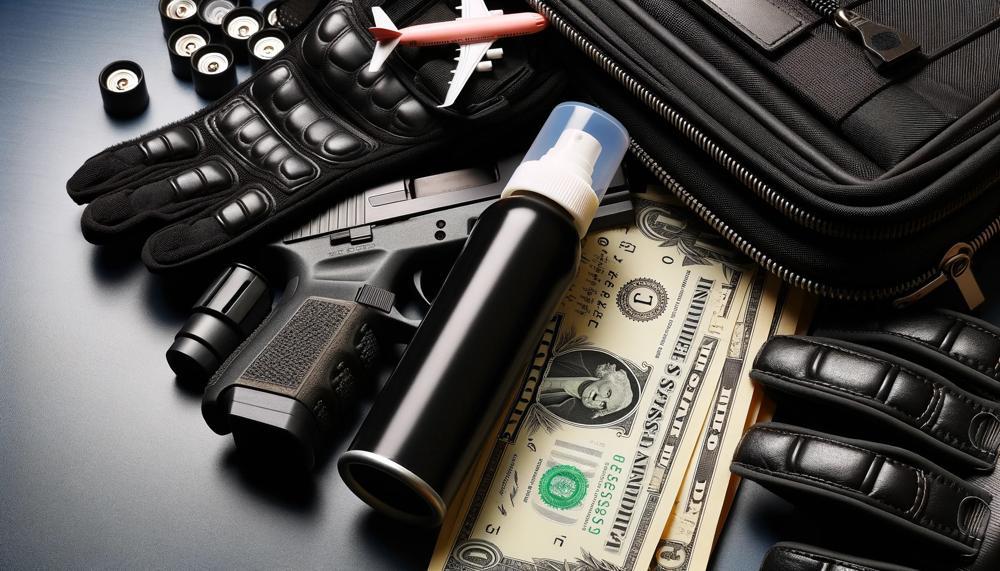
Why is pepper spray restricted on planes?
Pepper spray, a common personal defense tool, is heavily regulated in the aviation environment. The concerns that mandate such restrictions are rooted in the unique conditions aboard an aircraft and the potential risks associated with the use of pepper spray in such an enclosed space.
Capsaicin Concentration: A Double-Edged Sword
Pepper spray contains capsaicin, which is the active component that causes the intense burning sensation. While effective for self-defense, its high potency can be problematic in the cabin of an aircraft.
In an enclosed space, an accidental discharge could incapacitate passengers and crew, leading to chaos and even incapacitating those who are responsible for the safety and operation of the plane.
| Risk | Details | Mitigation |
| Accidental Discharge | A careless moment or a faulty safety mechanism can lead to an unintentional release. | Strict regulations and safety mechanisms are required for transport in checked luggage. |
| Potential Misuse | Pepper spray could be used maliciously to compromise the safety of passengers and crew. | Prohibition of carry-on possession to prevent access in the cabin. |
| Flammability | Some self-defense sprays are flammable, posing a fire risk. | Allowance of only limited quantities with less than 2% tear gas content. |
Legal and Regulatory Hurdles
The TSA’s allowance of a single 4 fl. oz. container in checked baggage, subject to specific conditions, is an attempt to balance personal safety with the collective safety of passengers. Given the potential for misuse by malevolent actors, these items are banned from carry-ons to minimize the risk of hijacking or terroristic actions.
International Travel: A Patchwork of Laws
When crossing borders, the legality of pepper spray can vary widely. Some countries deem it illegal, while others have stringent regulations. International travelers must not only abide by airline policies but also respect the legal landscape of their destination.
Practical Points for Passengers
Passengers should be mindful that while pepper spray is a self-defense staple, its presence on a plane is bound by a web of safety protocols. The expiration of the product and its packaging also play a role in ensuring that outdated or potentially malfunctioning canisters do not pose a risk during transport.
Mace versus pepper spray
When we talk about personal safety, the terms “Mace” and “pepper spray” often pop up, seemingly interchangeably. But they’re not old mates with identical effects; they’ve got their own distinct punch.
Chemical Rundown: The Nitty-Gritty
Mace is the brand name that once referred to phenacyl chloride (CN), but now often refers to sprays primarily composed of oleoresin capsicum, much like pepper spray.
Pepper spray’s fiery ingredient is oleoresin capsicum (OC), derived from hot cayenne peppers.
| Aspect | Mace (Original) | Pepper Spray |
| Active Ingredient | CN (Phenacyl chloride) | OC (Oleoresin capsicum) |
| Effects | Tears and pain | Blinding pain, inflammation, coughing |
| Usage | Less common today | Widely used for self-defense |
Jet-Setters Beware: Take Note Before You Fly
Both Mace and pepper spray can hitch a ride in your checked baggage under these conditions:
- Your canister must be a petite 4 fl. oz. (118 ml) or smaller.
- A safety mechanism to prevent accidental discharge is a must.
- The spray should contain no more than 2% tear gas.
Mind you, check with your airline as well; they might have their own fussy rules.
A World of Caution: Laws and Expiry Dates
Here’s a twist: different places, different faces. Laws on carrying these sprays vary like the weather, so check the forecast for your destination. And keep your eyes peeled for the expiration date—these sprays go off like old cheese.
Is pepper spray legal in every state?
Pepper spray, a common self-defense tool, is indeed permitted in checked baggage across all 50 states when flying, but there’s a caveat or two to keep in mind. Here’s a breakdown to ensure your travels remain as hassle-free as possible.
Packing and Restrictions
To keep your luggage above board, there are a few TSA and airline directives you’d do well to heed:
| Aspect | Specification |
|---|---|
| Permission | Allowed in checked baggage |
| Container Size Limit | 4 ounces (118 mL) per canister |
| Quantity Limit | Up to 2 canisters per person |
| Container Material | Metal or plastic with safety mechanism |
| Declaration to Airline/TSA | Required |
Mindful Travel
Always pack pepper spray in the spirit of self-protection, never aggression. Missteps might not just cause a kerfuffle but could land you in legal hot water.
International Sojourns
If you’re venturing beyond the US, the plot thickens. Double down on your research for the country’s laws you’re visiting—don’t assume what flies in the States will do elsewhere.
To nutshell it: Yes, pepper spray can tag along in your checked baggage while whisking across all 50 states, but make sure to play by the rules and stay in the know about your destination’s local laws.
Airline policies on pepper spray
When considering stowing pepper spray in your checked baggage, it’s key to be aware of the policies set by major airlines. The rules can be quite specific, and it’s your job to comply. Here’s the nitty-gritty on what you need to know:
- Size Matters: Your pepper spray canister must be a petite 4 fl. oz. (118 ml) or smaller.
- Safety First: A safety mechanism to prevent accidental discharge is a must-have.
- TSA and FAA Agreement: Both the TSA and FAA agree that pepper spray is a no-go in your carry-on but can be checked if you play by the rules.
Below is a table outlining the stance of some major airlines on the matter:
| Airline | Pepper Spray in Checked Bags | Additional Notes |
| Airline A | Allowed | Must adhere to TSA’s 4 fl. oz. regulation with safety mechanism |
| Airline B | Allowed | Conformation to local laws at both departure and arrival destinations needed |
| Airline C | Not Allowed | Prohibits all forms of self-defense sprays |
Keep in mind, rules can be as fickle as the weather, changing without much ado. So, make sure you check the specific airline’s policy before you pack. Also, remember to verify the legality of pepper spray at your destination – you don’t want to be caught out in a foreign place where your self-defense tool is a no-no.
Tip: Before you jet off, give the airline a bell to confirm the current stance on pepper spray – it’s better to be safe than sorry.
Remember, while the TSA sets the stage for what’s allowed, airlines can add their own twist to the plot. And don’t forget, if you’re globe-trotting, pepper spray might not get the green light at customs.
Bear spray
No, bear spray isn’t allowed in checked bags during air travel. Here’s a quick glance at the rules:
| Item | Carry-on Baggage | Checked Baggage |
| Bear Spray | Prohibited | Prohibited |
| Pepper Spray (for self-defense) | Typically allowed with restrictions* | Typically allowed with restrictions* |
*Restrictions for pepper spray usually include a safety mechanism to prevent accidental discharge and a limit on the quantity.
The Federal Aviation Administration (FAA) categorizes bear spray as a hazardous material, which is why it’s a no-go for air travel luggage. It’s a potent pepper spray meant to deter bears, not a personal defense pepper spray, which can sometimes be allowed with strict limitations.
Before you jet off, it’s wise to double-check with your airline. They’ve got the final say and can provide the most up-to-date info on what’s allowed in your bags. Remember, even if personal defense sprays are permitted, they’ve got to meet the airline’s criteria – typically this means a volume limit and a safety mechanism.
If you’re heading to a bear hotspot and reckon you’ll need some spray for peace of mind, consider buying it once you land. Just be sure it’s legal where you’re going – you don’t want any legal bother on your hands.
Keep these pointers in mind, and you’ll be all set for a hassle-free flight, minus the bear spray in your bag.
Rules for international travel
Traveling with pepper spray as a means of self-defense in checked baggage is subject to strict rules and regulations. Below, I present the essential guidelines to ensure your compliance with international travel requirements.
| Item | Specification | Notes |
| Quantity Allowed | One 118 ml (4 fl. oz.) container | Per passenger |
| Safety Mechanism | Required | Prevents accidental discharge |
| Chemical Limit | <2% CS or CN | By mass of tear gas |
| Airline Policies | Varies | Check before travel |
| Legal in Destination | Varies | Check local laws |
| Alternative | Purchase on Arrival | Avoid travel issues |
Conclusion
In conclusion, you should always put your safety first while traveling. You may, in fact, carry pepper spray in your checked baggage as long as you strictly follow the rules. The TSA allows up to 2% tear gas concentration in a single 4-ounce bottle with a safety device. These fundamental guidelines are established to guarantee everyone’s safety in the air, even if airline policy may differ.
Recall that carrying bear and keychain pepper sprays is prohibited, and that visitors from other countries must abide by a complex web of local regulations. Verify expiry dates, lock down safety features, and declare pepper spray as necessary. Although these procedures can appear cumbersome, they aid in maintaining a safe flying environment and preventing any travel mishaps.
Although pepper spray is a useful weapon for self-defense, these strict rules are necessary due to the possible hazards it poses in the cramped confines of an airplane. The TSA strikes a delicate balance between protecting you from unintentional discharges and misuse that can put passengers and crew members in risk and enabling you to carry personal protection.
Therefore, before you take off, confirm that your pepper spray is lawful in your location, complying with TSA regulations, and properly packed. By keeping these pointers in mind, you can make sure that your trip goes well and concentrate on the most enjoyable parts of it.
